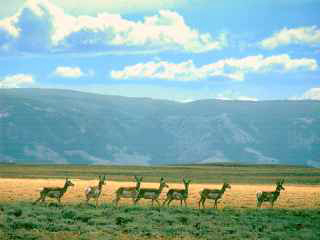|
Earth
Biomes
On the drier side of the grassland
biome lies the steppe grasslands.
Vegetation must cope with the summer soil
moisture deficit common to the steppe
climate in which this formation class
is found. Here, tall grass prairie gives way to
grasses smaller than a half meter (2 ft).
Figure
13.21 Mixed Tall and
Short grass
prairie of the U.S. Great Plains.
(Courtesy NRCS)
Toward the drier portions the ground
cover becomes sparse with patches of open ground found
between clumps of grass. Overgrazing of the steppe
vegetation leads to accelerated wind erosion and
desertification.
Fires, especially those started by
lightning, are a natural occurrence in the grassland
biome. Fire destroys invasive species that compete
with grasses. Fire suppression and farmland conversion
have severely disrupted grassland ecosystems. Resource
mangers now use prescribed burning to restore the
health of prairie grasslands.
The Kalahari Desert actually isn't a
desert under present conditions, though it is covered
with much sand. It is a fossil desert found in the
tropical steppe biome. Parts receive over 250 mm of
precipitation, enough to support a cover of
vegetation. It is a fossil desert found in the steppe
biome. It' name is derived from the tribal word
Khalagari, Kgalagadi or Kalagare meaning "a waterless
place" or the Tswana word Keir, meaning "the great
thirst".

Figure
13.22 Wild Pronghorn
Antelope cross the short grass prairie of Wyoming.
(Courtesy NRCS)
Burrowing animals like ground squirrels, prairie dogs,
pocket gophers are common in the steppe grasslands of
North America. Burrowing predators like the black
footed ferret are considered an endangered species.
Watch: " National
Bison Range Wildlife Refuge - near Missoula,
Montana, MT."
Previous
| Continue
|